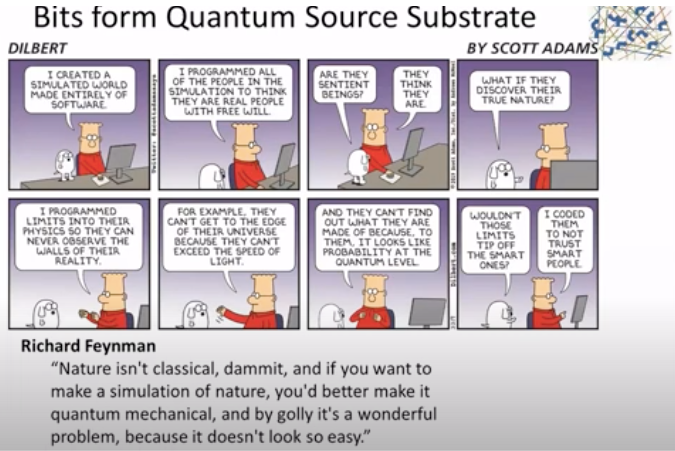Exploring the Simulation Hypothesis: Bridging Physics and Reality
Written on
Introduction to the Simulation Hypothesis
The concept of the simulation hypothesis has surged in popularity lately, likely due to advancements in computing and gaming technologies. As we develop our own simulations and enhance programming skills globally, the notion feels increasingly relevant. Influential figures like Elon Musk have openly discussed this idea, contributing to the ongoing debate in Silicon Valley. Additionally, films such as The Matrix and Free Guy have pushed the question of whether we exist in a simulation into mainstream awareness.
Theoretical Foundations: "It From Bit"
The phrase “it from bit,” introduced by physicist John Wheeler in his 1989 paper, "Information, Physics, Quantum: The Search for Links," encapsulates the idea that every physical entity stems from an immaterial source. Wheeler posits that reality fundamentally emerges from the formulation of yes-or-no questions and their resultant responses, suggesting that all physical phenomena are rooted in information theory.
Building on Wheeler’s concept, Dr. Melvin Vopson made significant strides in 2019 with his paper titled “The mass-energy-information equivalence principle.” In this work, he mathematically demonstrates the equivalence between information, mass, and energy, akin to Einstein’s mass-energy relationship. Vopson’s framework is traced back to Shannon’s 1948 communication theory. He theorizes that information could yield a measurable amount of mass, although current technology limits our capacity to detect it. In a follow-up study from 2022, Vopson proposed an experimental protocol to test this principle by observing a decay product from destroyed information.
Dr. Vopson founded the Information Physics Institute (IPI), which unites researchers, academics, and the public to deepen our understanding of information's fundamental role in the universe. Among its members is Dr. Doug Matzke, a notable scientist and researcher with expertise in computation, quantum mechanics, and metaphysics. Over his 45-year career, he has contributed significantly to various fields, earning him the nickname "Quantum Doug."
In his 2002 Ph.D. dissertation, Dr. Matzke elaborated on bit-physics as a mathematical model that utilizes topological bits to derive quantum computing principles. His 2020 book, Deep Reality, further explores these ideas, linking them to neural and quantum computing. He emphasizes two key aspects of bit-physics:
- “Bits are physical” (Landauer’s principle), thereby influencing the physical universe.
- “Bits are protophysical” (Matzke’s principle), suggesting that the mathematics of hyperdimensional bits is foundational to the multiverse's structure.
Dr. Matzke recently presented on this topic, providing insights into the intersection of bit-physics and the universe's structure.
In his presentation, he discusses his co-authored book, Deep Reality, which proposes a model where thought is intricately linked to the science of informational protophysics. This perspective addresses how information, thought, and meaning are interdependent on hyperdimensional states in both neural and quantum computing realms.
Potential Implications of Vopson's Principle
If Dr. Vopson’s principle holds true, it could have profound implications for technology and our comprehension of reality, particularly regarding the simulation hypothesis. The notion that information carries a minuscule amount of mass might enable advanced quantum computers to manipulate spacetime metrics. Instead of merely storing data, these computers could process it in a way that generates significant gravitational fields, potentially altering spacetime.
This line of thought invites intriguing parallels between the simulation hypothesis and unidentified anomalous phenomena (UAP). One might consider UAP as glitches in a simulation, akin to bugs in a video game. This raises questions about the nature of the creators or developers behind our reality, suggesting they could introduce new elements or patches to the simulation. The idea of superusers possessing extraordinary abilities further blurs the lines between technology and mythology, reminiscent of ancient tales where deities overthrow their predecessors.
Other Theories Worth Exploring
For those intrigued by these concepts, the hyperdimensional theory proposed by Pharis Williams, a former Los Alamos National Labs physicist, is worth examining. His unique approach to a unified field theory intersects with both thermodynamics and the UFO phenomenon. Additionally, Ken Shoulders’ pioneering work in electronics and his exploration of Exotic Vacuum Objects (EVOs) offer further avenues for investigation.

Conclusion
The exploration of the simulation hypothesis not only challenges our understanding of reality but also opens doors to innovative technological advancements. As we continue to investigate the intersections of information, reality, and advanced computation, the potential for new insights into our universe remains vast.